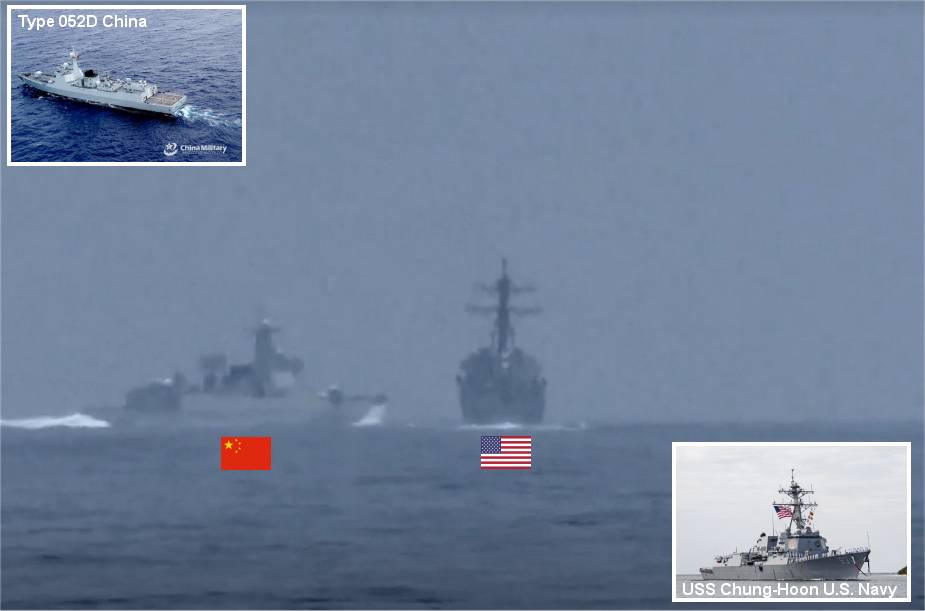Breaking news
Tensions Escalate: Chinese Warship's Close Encounter with U.S. Navy's USS Chung-Hoon Sparks New Concerns in Taiwan Strait.
Tensions continue to rise between China and Taiwan with a new incident this June 3, 20233, a new video was published showing a Chinese warship Type 052D destroyer coming within 150 yards of hitting the U.S. Navy USS Chung-Hoon Arleigh Burke-class Aegis destroyer in the Taiwan Strait.
Follow Navy Recognition on Google News at this link
 A Chinese Navy Type-052D destroyer cut across the bow of the U.S. Navy USS Chung-Hoon Arleigh Burke-class Aegis destroyer on June 3, 2023. (Picture source video footage)
A Chinese Navy Type-052D destroyer cut across the bow of the U.S. Navy USS Chung-Hoon Arleigh Burke-class Aegis destroyer on June 3, 2023. (Picture source video footage)
In an announcement issued on June 3, 2023, the U.S. Indo-Pacific Command (USINDOPACOM) revealed that the LUYANG III DDG 132, a Chinese Navy warship, executed maneuvers that were deemed unsafe in the proximity of the U.S. Navy ship, USS Chung-Hoon.
In compliance with international law, the USS Chung-Hoon (DDG 93) and HMCS Montreal (FFH 336) carried out a routine transit from south to north through the Taiwan Strait on June 3. This transit occurred over waters where international freedom of navigation and overflight apply. During this transit, the Chinese People's Liberation Navy warship LUYANG III DDG 132 (PRC LY 132) made maneuvers deemed unsafe close to the Chung-Hoon. The PRC LY 132 overtook the Chung-Hoon on its port side, crossing its bow at a distance of 150 yards. The Chung-Hoon, in order to prevent a collision, maintained its course and reduced its speed to 10 knots.
The PRC LY 132 again crossed the bow of the Chung-Hoon, this time moving from starboard to port at a distance of 2,000 yards and remained off the Chung-Hoon's port bow. At its closest point, the LY 132 was only 150 yards away. These actions of the LY 132 were in violation of the maritime 'Rules of the Road' that dictate safe passage in international waters.
The USS Chung-Hoon (DDG-93) is an Arleigh Burke-class guided missile destroyer in the United States Navy. She is a multi-mission ship with a focus on air, surface, and sub-surface warfare. Equipped with advanced sensors and weapons systems, including the Aegis combat system, it's designed to handle a variety of combat scenarios.
The ship's armament includes anti-aircraft, anti-submarine, and anti-surface weapons, as well as being equipped for ballistic missile defense. The USS Chung-Hoon also carries two Seahawk helicopters.
The LUYANG III DDG 132 Type 052D destroyer is a category of guided missile destroyers deployed by the Chinese People's Liberation Army Navy (PLAN). These vessels symbolize a notable advancement in Chinese naval capabilities, with the integration of state-of-the-art radar and weaponry systems.
The Type 052D was designed as a progression from the Type 052C, incorporating insights garnered from the previous model and implementing novel technologies. Since its initial launch in 2012, the Type 052D is broadly considered as an element of China's initiative to modernize its naval fleet and cultivate a "blue-water" navy with the capacity to operate on a global scale.
One of the distinctive features of the Type 052D is its multi-function phased array radar system, which is analogous to the Aegis Combat System utilized by the United States Navy.

The Chinese Navy, besides air incursions, has staged expansive military drills in proximity to Taiwan. (Picture source China MoD)
Historically, the relationship between the People's Republic of China (PRC) and Taiwan (officially known as the Republic of China, ROC) has been fraught with tension. This primarily stems from the PRC's claim that Taiwan is part of its territory, a view that Taiwan, with its distinct political system, disputes.
From 2016 onwards, tension between the two increased. The election and re-election of the Democratic Progressive Party, which supports Taiwan's independence, didn't sit well with Beijing. In response, China ramped up its pressure tactics on Taiwan, including conducting military exercises and luring away Taiwan's diplomatic allies.
Furthermore, the United States, a significant player in this geopolitical dispute, has fueled these tensions despite not officially recognizing Taiwan as a separate country. The administrations of both Trump and Biden amplified their support for Taiwan, including weapon sales and diplomatic engagements. This step, while bolstering Taiwan's position, drew the ire of Beijing.
In a conference held on June 1, 2023, General Li Shangfu underscored during a discussion with Singapore's Defense leader, Ng Eng Hen, that Beijing would not stand by as Taiwan's Democratic Progressive Party solicits backing from other nations for Taiwan's autonomy. This stance was reaffirmed by Senior Colonel Tan Kefei, a spokesman for the Chinese defense ministry. It's crucial to acknowledge that Taiwan's independence is not officially recognized by the majority of countries, including the United States. Nonetheless, Washington condemns any forced alteration to the existing state of affairs.
Heightened tension in the region has been observed recently, owing to a series of perceived intimidation maneuvers by the Chinese military targeting Taiwan, a development that has roused anxiety within the global community. These maneuvers appear to underscore China's long-held assertion of jurisdiction over the island.
The Chinese Navy, besides air incursions, has staged expansive military drills in proximity to Taiwan. These drills, involving aircraft carriers, warships, and submarines, are a testament to China's formidable military might and its preparedness to uphold its territorial assertions. The underlying purpose of these naval drills is to exhibit China's capability to exert its force within the region.


























